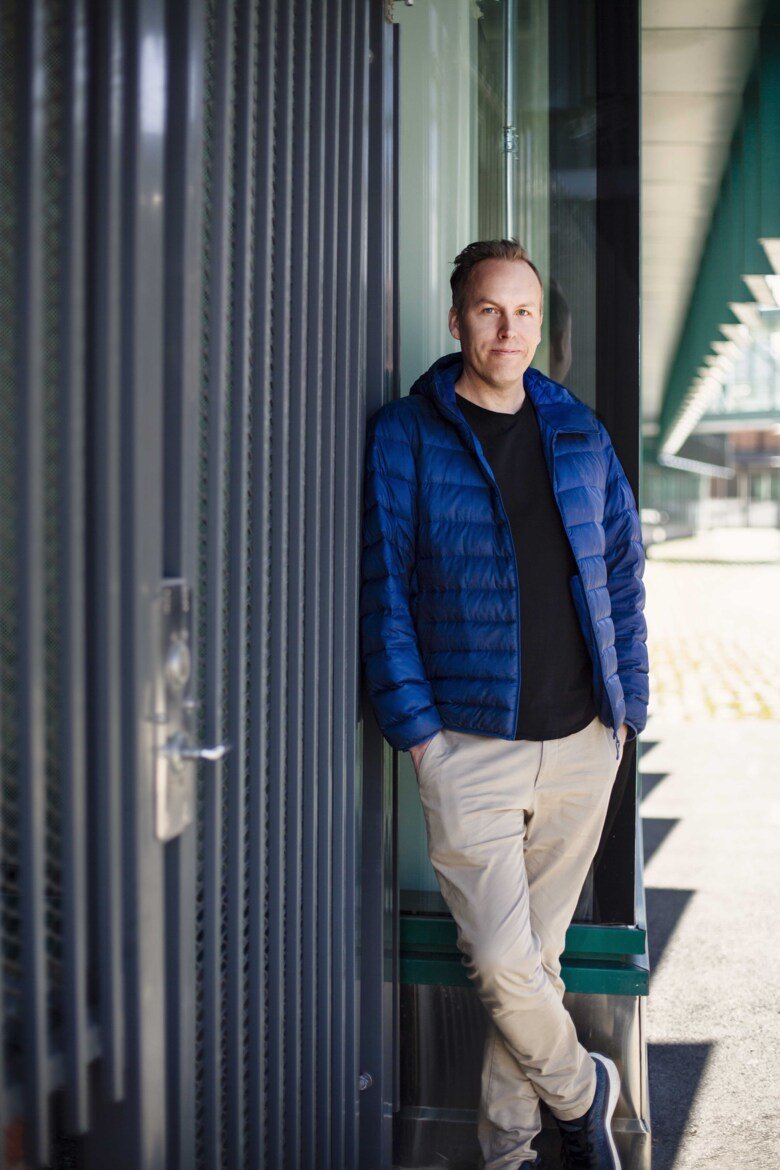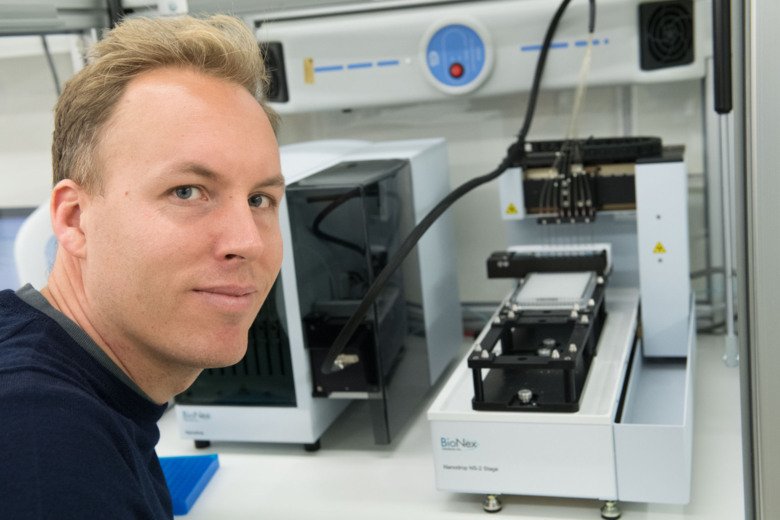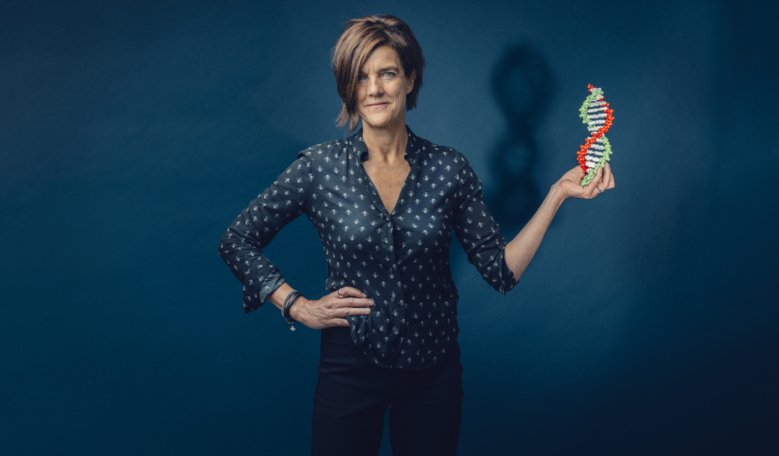Rickard Sandberg is a molecular codebreaker

Solving the logic of life. This may seem like an overwhelming task. But for Professor Rickard Sandberg, this is the objective.
Text: Cecilia Odlind for the magazine Medicinsk Vetenskap issue nr 2, 2023
Which genes are expressed in a particular cell at a given time affects which proteins are present in it. This in turn influences the character of the cell. Understanding more about what controls gene expression in a cell has been the focus of Rickard Sandberg's research. While other researchers are interested in the function of individual genes, his goal is more to understand and map the overall principles of how these molecular processes are regulated.
“Gene regulation is part of the logic of life itself. Nobody understands it in detail today, but we need to do it and we are progressing,” he says.
Rickard Sandberg has been described as humbly superior. It was his supervisor when he was working on his PhD, Professor Ingemar Ernberg, who characterised him in this way, and it is perhaps a fitting disposition for someone who sets out to crack the “logic of life”. Rickard Sandberg describes himself as careful and attentive to detail - when necessary.
“But to succeed as a researcher, I think it is also important to care a lot about what you do. For a while, my research group became too big, with up to 15 people. But then I felt more like a kind of administrator. I want to be part of the programming and analysing and understanding. I think it would be sad and dangerous as a researcher to give up the participation,” he says.
Wants to understand gene regulation
The primary focus of Rickard Sandberg's research is to understand in detail how gene regulation is controlled.
“There are around a thousand DNA-binding proteins in our DNA but we do not know how they affect the regulation of gene expression. Which of them influence frequency, which of them influence quantity? How do they exert their effect, which ones promote expression and which ones inhibit it? We want to map the rules for this,” says Rickard Sandberg.
Another line of research involves what is known as splicing. It is a modifying process that occurs after a gene is coded from DNA to RNA. By removing or adding a section of RNA, the same original gene can result in several different proteins. The methods currently used to map active genes in a cell can measure a specific gene expression (i.e. which DNA is transcribed to RNA) but not subsequent modifications, such as splicing. But now Rickard Sandberg's research team has found a way to measure this and at the same time robotised the process so that they can analyse a large number of cells per day. In this way, they hope to map splicing regulation in brain cells.
“It is known that the proteins involved in synapses, i.e. the proteins that neurons use to communicate with each other in the brain, are extremely highly regulated by splicing. But it is not known how this is taking place. We want to systematically map the regulations of the process and investigate whether splicing can affect which neurons get the chance to communicate with other neurons and thus ultimately influence behaviour,” says Rickard Sandberg.
Variants of many of these proteins have been found to be associated with several psychiatric disorders such as schizophrenia, bipolar disorder and depression. He believes that there is a lot of interesting new knowledge here that can increase our understanding of the brain. The robotisation of the process has meant that the research can be accelerated.

“We have built a really neat robotic arm in-house, a 3D printed grabber, 12 PCR machines, a centrifuge and more. The robot helps to scale up our main activity, which is the study of gene expression in individual cells. For example, in a previous project we analysed hundreds of thousands of cells. Two people worked full-time for 10 weeks to complete this. Now the robot can do the job almost entirely by itself in about a week,” he says.
The third path of Sandberg's research - “more of a vision so far” - is to improve and accelerate how RNA sequencing can be used in healthcare and clinical research.
“Many of the methods currently used by healthcare providers are expensive and often based on older technologies. We would like to develop measurement methods that are cheaper and can be scaled up so that clinical research can rapidly measure RNA expression in many samples. This could be used, for example, to determine the type of tumour, how people respond to treatment or how a disease progresses,” says Rickard Sandberg.
Discoveries often surprise him
Discoveries within research often surprise him. For example when his research team conducted the first single cell experiments in 2011, measuring RNA expression in individual cells. Previously, little was known about how gene expression varied between cell types and within a particular cell type.
“Many wondered how on earth the information from a single cell could be useful.” “There will be too much noise,” critics said. “Nobody knew how this would turn out,” he says.
But it turned out that the first 12 cells, four cells of three different types, expressed hundreds of unique genes that characterised each of the three cell types.
“Consequently, we showed that the gene expression profile of one individual cell is so specific that it directly indicates which type of cell it is. This is very useful information,” says Rickard Sandberg, quoting the example from the same research work, which was published in the prestigious scientific journal Nature Biotechnology in 2012.
The researchers also analysed tumour cells from the blood of cancer patients and found that these cells expressed genes specific for the original tumour, knowledge that is potentially of clinical value.
“Later on we also showed that RNA molecules are produced in pulses, so-called bursts, and that this can be linked to regulation. Previously, only the mean expression could be measured. This is important for the basic understanding of how gene regulation works,” says Rickard Sandberg.
Rickard Sandberg was one of the first students in the biomedical programme at Karolinska Institutet. In parallel, he studied mathematics at KTH and in his spare time he was a “hobby programmer”. That there is a connection between mathematics and biology has always been natural to him.
“When I started my research group in 2008, it was unique that the “dry lab”, where bioinformaticians work on computational biology, was the same size as the “wet lab” where the experiments are done. But today it is the norm,” he says.
Highlights the importance of an open discussion
Rickard Sandberg sees a major challenge for the research community in the fact that the merit process - which is based on the scientific journals in which you publish - is so sensitive.
“The way the system is currently structured, a single publisher of a journal can have a lot of power over the future career of an individual researcher. Whether an article is accepted or not may depend, for example, on whether the topic is considered “trendy”. But I believe that the system should favour great research and not short-term hype or the financial interests of the journals. It would be even more fun to do research if this process were more robust,” he says.
Rickard Sandberg has no solution to the problem but highlights the importance of an unfiltered, neutral and open discussion of research results.
“It is important that there is a lively critical conversation. It is often easier for senior researchers who have most of their career behind them to be critical because they are less dependent on others,” he says.
Rickard Sandberg himself has published in very prestigious journals over the years. During the interview, he also points out that he beats everyone in the lab in racket sports. And that his computer screen is probably the widest in the university (yes, it's definitely the widest screen I have seen). You seem to be a winner?
“Life is simply too short to work on a small screen,” he says.
About Rickard Sandberg
Title: Professor at the Department of Cell and Molecular Biology, Karolinska Institutet. Elected in 2019 to the Nobel Assembly, a body of 50 professors who decide who will be awarded the Nobel Prize in physiology or medicine. He was recently awarded the Torsten Söderberg Academy Professorial Chair in Medicine.
Age: 45
Family: Mrs. Maria Kasper, Associate Professor at Karolinska Institutet. Together they have two children, aged five and seven.
Role models: My parents, they are the most straightforward and helpful people I know. Dad is always very positive and solution-oriented, while mom is calm in a good way. I think I am quite similar to them but none of them have an academic career. They find my research very exciting even if they do not understand all the details. The most important thing for them is that I am doing something I enjoy.
This is how I relax: Then I do something completely different, such as playing tennis and other racket sports.
Rickard Sandberg on…
... hoodie: It is a cosy garment that I feel comfortable in. I still use my 10-year-old hoodie all the time.
… why he became a scientist: No one in my family had been involved in research but it sounded ingenious that you can constantly work on new issues, I thought that it would never be boring. And today I think that is true.
… the fun of research: I like all aspects of the research: Thinking up problems that need to be solved, figuring out how to solve them and then testing different ways of solving them.
… poor research: A lot of errors are published, results that researchers in a certain field find interesting or new but that researchers in another field consider old or even revealed as being artifacts.
More reading
 Photo: Ulf Sirborn
Photo: Ulf SirbornHe is awarded the Torsten Söderberg Professorship
KI Professor Rickard Sandberg has been awarded the Torsten Söderberg Academy Professorship in Medicine by the Royal Swedish Academy of Sciences, a donation of 10 million Swedish kronor for a five-year period.
 Photo: Alexander Donka
Photo: Alexander DonkaThey see beauty in the smallest things
A lot of medical research revolves around molecules and how they function. These tiny components of our bodies can be very important for our health. Meet three researchers who each present their favourite molecule
